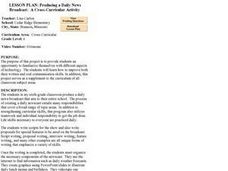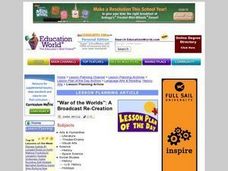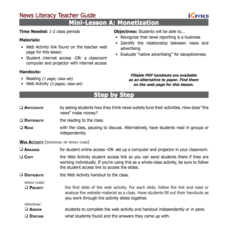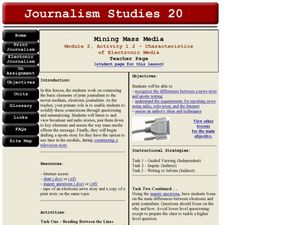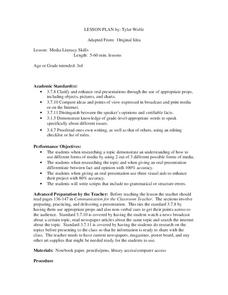Curated OER
This Just in! Nile Network News Update
Have your young reporters research contributions of the ancient Egyptians, draft scripts, and broadcast their stories live on the Nile Network News. Depending on class size and age, topics may be brainstormed or assigned. The detailed...
Curated OER
Watching the Clock: An activity to build media-savvy students
Students analyze time constraints on broadcast news. They apply data collecting and data display skills. They identify the difference between news progams and the evening news.
Curated OER
Shaping the News
Students explore television journalism. In this journalism activity, students discuss the attributes of television broadcasting. Students then review their journalism code of ethics and then conduct research for stories that have a moral...
Carolina K-12
World War II through the Radio Waves
Young historians channel the very medium used to convey news during World War I. They create and present a five-minute radio broadcast on a particular topic from the war, such as the roles of African Americans and women, war bonds,...
Curated OER
Producing a Daily News Broadcast: A Cross-Curricular Activity
Sixth graders create a daily newscast which they broadcast to the whole school. They write the scripts for the broadcast, after reviewing interviews, feature writing, and proposals. They organize the newscast for presentation and edit...
Curated OER
"War of the Worlds": A Broadcast Re-Creation
Why did Orson Welles' 1938 Broadcast of a adaptation of H.G. Wells' The War of the Worlds cause such a panic? To answer this question, class members listen to the original broadcast and research the panic that resulted. They then engage...
Curated OER
The Power of One: Convergence in Scholastic Media
Pupils explore the different forms of media utilized by journalism including writing, photography, video, sound and the Internet. In this journalism lesson, students compare and contrast the ways in which information is presented between...
iCivics
Mini Lesson A: Monetization
Advertising is everywhere! Does your class know that their attention span is for sale, even when they're watching a simple news story? The second installment in a five-part series from iCivics examines the relationship between news...
Newseum
Bias Through History: Analyzing Historical Sources
Young journalists use the E.S.C.A.P.E. (evidence, source, context, audience, purpose, and execution) strategy to evaluate historical and contemporary examples of bias in the news. The class then uses the provided discussion questions to...
Curated OER
How Media Shapes Perception
Students explain the impact that the media may have in shaping their intellectual and emotional responses to current events. They examine broadcast and Web-based news sites to find subtexts through the use of language, audio, and visual...
Carolina K-12
The Major Conferences of World War II
Young historians create a 1940's news radio broadcast on the five major World War II conferences, including the Atlantic, Casablanca, Tehran, Yalta, and Potsdam.
Curated OER
Mining Mass Media
Students take a closer look at the attributes of electronic media. In this journalism lesson plan, students compare and contrast electronic and print versions of the same news stories. Students then write their one broadcast news stories.
Curated OER
What is News?
Eighth graders discover elements that make a story newsworthy. They play an online game about newsworthy stories and complete a worksheet with partners. They also examine the difference between facts and opinions.
Curated OER
Current Events
Students research current events and simulate a newscast of a current news story. They watch the evening news and write a summary of a story of interest, conduct Internet research and complete a worksheet on a current event, and...
Curated OER
News Broadcasts
Pupils create a news broadcast after studying example broadcasts about disaster relief organizations. In this broadcast news lesson, students research disaster relief organizations and then write a news broadcast related to a disaster....
Facebook
Versions of Media Texts
Verification of provenance and the original source of an image or video can be a long and winding process. Young journalists learn about the difficulty of finding the original source of a scrape, a copy of an original news story, and...
Curated OER
NEWSCAST
Students present a 2-3 minute version of a newscast. They include three of the following: news, current events, weather and sports. They design a poster to include at least four pictures to be referenced in the report. They review and...
Curated OER
The Weekly News, Part 2
Sixth graders use articles they've previously written to produce a school news broadcast. For this journalism lesson, 6th graders discuss the goals of a news broadcast and use previously written articles to plan a news broadcast....
PBS
Finding Story Ideas
Pitch your best news story to your news team, or the peers in your journalism class, with a lesson about finding, reporting, and presenting a story. After watching clips of different examples, as well as strategies for finding the best...
Newseum
Is It Fair?
Young journalists learn how to analyze word choice, context, and counterpoints to judge the fairness of a news story. They practice using these tools to judge a series of headlines for the story of Goldilocks and the Three Bears. They...
Curated OER
What's New in the News?
Students explore the news. They research Internet news sites, newspapers, and magazines and select four areas to summarize. They simulate a news announcer by summarizing the news and including supporting details for a particular day.
Curated OER
Media Literacy Skills
You're on camera! Third graders find a news story and research it to get more information. Everyone uses their found information to write a script and create their own news broadcast!
Facing History and Ourselves
The Power of Images
One picture but a thousand stories. As a part of a case study of how the death of Michael Brown was reported by professional news sources and on social media class members examine the reactions of various groups to a photograph taken by...
Media Smarts
Bias
See how bias operates firsthand. Half of the class reads one article while the other half reads another article on the same event. The obvious differences emerge when the two sides talk about their observations though. Several handouts...






